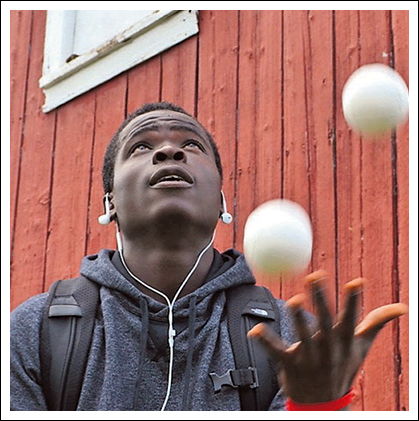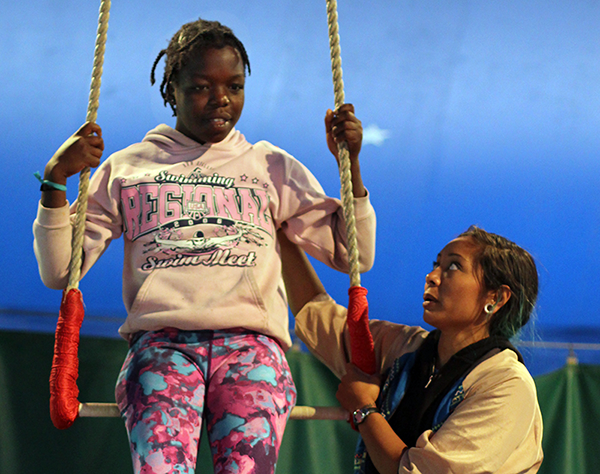In Uncertain Times For Circuses, Smirkus Thrives
Editor’s note: This story first appeared in the Times Argus/Rutland Herald newspaper on July 1, 2017 and was written by Stephen Mills. Video used by permission.
The year 2017 marks some important milestones in circus history, both nationally and locally. This year marks Smirkus’ 30th anniversary, and also when its longtime executive director, Ed LeClair, will step down.
“It’s very much like the politicians say, ‘I’m going to spend more time with my family,’” said LeClair, who has overseen 15 annual seasons of the Greensboro traveling troupe. “I’ve spent my career making stars and now I get to sit back and watch the stars.”
Not quite, it seems. LeClair revealed that there will be a second act in the circus world for him.

Patrick Chikoloma, 18, of Zambia, who is a member of Circus Smirkus’ current traveling troupe of performers, demonstrates his juggling on the Greensboro campus of the 30-year-old Vermont youth circus. DAVID W. SMITH / TIMES ARGUS
LeClair said he would be part of a new organization that will try to “unify the circus” in an attempt to spur a comeback for the industry nationally. “Right now, it’s referring to itself as ‘Circus Umbrella,’” LeClair said. “With the demise of Ringling Bros., and Big Apple Circus, the whole youth circus movement is really growing, yet the professional area is really diffused.”
A number of circus industry leaders are getting together to help find common ground, LeClair said.
LeClair was also sanguine about his time with Smirkus and his departure.
“I’m really filled with pride because this year we have three alumni come back to coach, and I get to see the love that they have for this place and the excitement they feel to be able to give back to the kids now,” said LeClair.
Speaking on Tuesday while travelling to the Smithsonian Institute Folk Festival in Washington, D.C., with a Smirkus troupe he selected to perform, company founder Robert Mermin echoed LeClair’s optimism. “I never expected to reach this landmark. It’s extremely gratifying to watch the older Smirkus generation, now experienced professionals, return as top-notch coaches. What a joy.”
That boomerang effect that is not uncommon for Smirkus. Many former students return year after year to join the staff or work during summer camps with circus students. There are camps for children and adults, and school residencies are also offered.
Abby Suskin, of East Montpelier, was still a student at U-32 in East Montpelier when she started at circus camp in 2000 and was a trouper each summer until 2006, when she graduated from high school and joined Smirkus as part of its full-time summer staff.
“My mom let me ‘run away’ and join the circus when I was 12 years old,” she said. “I fell in love with performing, that feeling that circus is a special art form when you’re within inches of your audience. You can see the live impact you’re having on kids and their parents and everyone who’s there to see the show, and that energy is infectious.”
As a coach, Abbey Jermyn said she sees the same drive and ambition in other young hopefuls just joining as campers or graduating to troupe potential.
“They love the challenge, they rise to it and they like to be pushed,” she said.
Also returning to the student camp this year are Abbey’s twin sister, Lucy Jermyn, of Montpelier, and their brother, Ivan, who has been on the circus circuit as an acrobat and clown while studying physical theater in college.
Smirkus is also known to be something of a family affair, both literally and figuratively. Members of the cast and crew include relatives as well as seasoned professionals and performers from other circuses like Ringling Bros. They include Troy Wunderle, artistic director for 20 years, his wife, Sara, the assistant director, and their 13-year-old daughter, Ariana, who is in the traveling troupe this year.

Twin sisters Lucy and Abbey Jermyn, of East Montpelier, have progressed from campers to staff at Circus Smirkus, along with other members of their family. PHOTO BY MICHAEL JERMYN
When Abbey Jermyn’s mother, Alice Day, the school nurse at Twinfield Union School in Plainfield, first signed her kids up online for the Smirkus camp, she answered a circus ad for a nurse and was accepted. She’s still there 11 years later.
“It’s a joy to be here, just knowing that we’re making a huge difference in the lives of these kids, doing a good thing,” she said. “For a lot of the kids, this is their favorite place to be all year. There’s always magic here.”
Many students return each year to compete for one of just 30 coveted spots in the traveling troupe that will tour the region for what has become a calendar highlight for many communities.
The theme of this year’s show is “Midnight at the Museum.” Without giving too much away, Creative Director Mark Lonergan said he got the idea for this season’s show from visits with his 3-year-old son to the American Museum of Natural History, with numerous exhibits that inspired the characters, costumes and capers of this year’s cast.
“What’s really striking is how museums — created centuries ago as displays of exotic items from private collections — can be a source of wonder and magic in 2017,” Lonergan writes in the circus playbill. “With all our high-tech distractions, a place of real objects, some hundreds of years old, can still capture our imaginations in a profound way. What better way to celebrate 30 years of Smirkus than with a show that looks backwards and forwards simultaneously.”
It was business as usual this week in Greensboro, with dozens of students buzzing around Smirkus’s two campuses.
The Circus Barn, Inc., about three miles from the center of Greensboro, is where the nonprofit was founded by Mermin in 1987. It is also where the annual Smirkus season premieres its show on Sunday before the road tour that will make 17 stops, with 69 shows in five states: Vermont, New Hampshire, New York, Massachusetts and Maine.
The current student camp, a short drive out of the center of Greensboro, is a site purchased and opened in 2015, and includes comfortable camp-style dormitories and shared living spaces. The camp serves 84 campers every session — and a total of 600 young and adult students each season — with 39 staff. The high student/staff ratio includes both circus coaches and camp counselors who attend to students’ social and emotional needs.
There are onsite training tents for aerials, acrobatics, juggling, clowning, balance and other skills.
Joining the camp again this year are the Carlson sisters — Estherline, 11; and Anya, 10, of Montpelier, who said they are excited to be at the camp and learning new skills every day.
“The tightrope walking looks easy — we have a slack line (to practice) at home — but it’s really hard,” Anya said.
“You think you can’t do it, but when you keep doing it, it becomes easier,” Estherline said.
Asked what makes a good circus experience, Anya replied: “Teamwork.”
“Doing fun activities,” Estherline added: “At other camps, they want to talk too much but here they want to get to the fun part.”
Asked if they missed their parents, Estherline said: “No, not really. We have so much to do that you don’t really have much time to think about them, which is good.”

Estherline Carlson, 11, of Montpelier, gets instruction from Trapeze Coach Alyssa Luna at Circus Smirkus Camp. PHOTO BY AMIRA SILVERMAN
Lending credence to Smirkus’ claim to be an “international” troupe is Patrick Chikoloma, 18, of the African nation of Zambia, where he performs for residents of a poor neighborhood in the country’s capital, Lusaka. A founding member of Circus Zambia, he visited the U.S. on a circus theater cultural exchange last year. After seeing Circus Smirkus in Vermont, he applied to join the troupe for a season, auditioned and was accepted. A princess of the Council of Chiefs in Zambia will travel to Vermont to see Chikoloma perform this year.
“I found my happiness in circus and being on stage, and back home, I use circus as a way to help people in Chibolya (a district of Lusaka) because everything about it is bad,” Chikoloma said. “It was good news that I made it to Smirkus.”
For all the razzle and dazzle that audiences have come to expect from classic circus capers, there is a backdrop of sometimes backbreaking work and big business operations to make the show seamless and successful.
Tent Boss Nat Brown has the responsibility for coordinating the transportation and safe erection of a variety of tents used at the camp and barn practice and rehearsal spaces, and when the troupe is on tour. The tour includes 80 people — crew, musicians, performers and coaches. It takes eight hours to set up the big top and backstage and concession tents, and to prep 200 costume pieces, 100 props, 70 spotlights and a mile of electrical cable.
Brown said tent technology has come a long way from older designs that required multiple bosses and crews for a variety of steps involved in circus operations.
“My job kind of falls under the category of catch-all, responsible for everything that’s on the lot,” Brown said. “When I put up the lot, I have to consider the grade of the lot, how the ground is going to hold, what happens if it rains.”
Brown said he became involved 15 years ago after his brother attended the camp.
“I kind of stepped into it because they were shorthanded one year and I helped out. I was doing construction before, and there’s an immediate satisfaction coming into an empty lot and within a few hours you have this,” Brown said, waving at several nearby tents.
On the business front, Judy Gaeth, the director of circus operations for the past 15 years, has had to manage tough times, and more than once referred to “putting out fires” when it came to managing the nonprofit’s $2.4 million budget.
“I don’t call it a fire unless it’s really a fire,” she remarked. “We have a lot of assets and we’re at the mercy of hitting every facet of the budget.”
At the end of the day, she said, it was still about the company’s bottom line.
“Butts in seats is incredibly important,” she said with a laugh. “If we can grab sponsors, that’s great, but filling the tent is very important.”
While there are many pieces to the puzzle when it comes to running the company, Ed LeClair summed up the company’s prime objective and the key to its success: “The function of Smirkus is to astound and amaze.”
Click here for tickets and tour dates.
